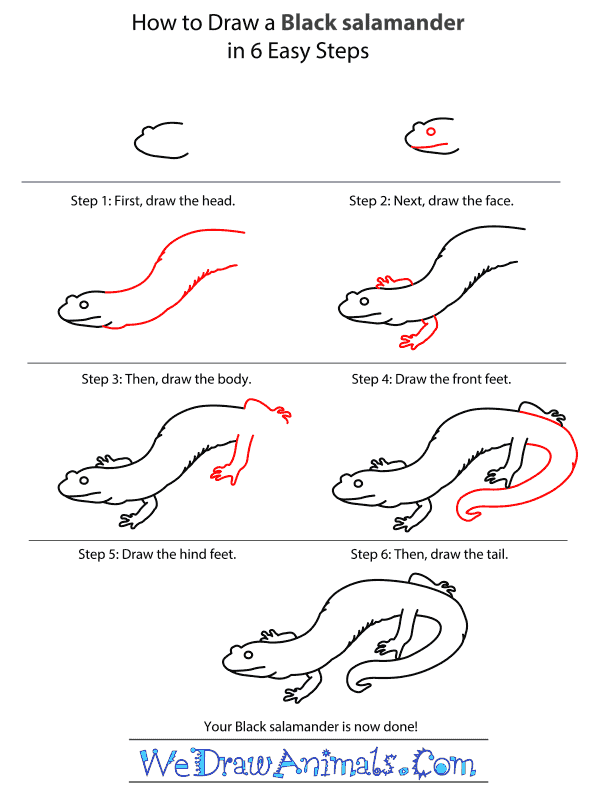In this quick tutorial you'll learn how to draw a Black Salamander in 6 easy steps - great for kids and novice artists.
The images above represent how your finished drawing is going to look and the steps involved.
Below are the individual steps - you can click on each one for a High Resolution printable PDF version.
At the bottom you can read some interesting facts about the Black Salamander.
Make sure you also check out any of the hundreds of drawing tutorials grouped by category.
How to Draw a Black Salamander - Step-by-Step Tutorial
Step 1: First, draw the salamander's egg-shaped head. There should be a small arch for where the far eye would be.
Step 2: Keep the face simple by drawing a line coming from the tip of the nose that stops just before the line for the neck ends.
Step 3: Next, draw the long body by using an S-shaped line that connects to the head and a slightly wavy curving line that connects to the neck. Draw short lines on its sides to show where the skin is wrinkling.
Step 4: Then, draw the front legs and feet. The black salamander has four round toes connected to short semi-thick legs.
Step 5: Attach the longer hind legs to the place where your body lines ended.
Step 6: The last step is to draw the thick curved tail of the salamander. The tail should be almost as long as the rest of the body.
Interesting Facts about the Black Salamander
The black salamander is also known as the speckled black salamander. It is endemic to the United States and lives in temperate forests and temperate grasslands. This salamander has a slim and slick body. It is black with spots on the body and the underneath is blackish grey in color. Young salamanders have pale yellow limbs. The black salamander grows to an average of 9.8 to 16.7 centimeters long. It prefers isolation and makes contact with other black salamanders only during the mating season. These salamanders are carnivorous and eat earthworms, leeches, small amphibians, and aquatic bugs. Black salamander eggs are left unprotected after they are laid, and the newly hatched babies are fully independent. Baby black salamanders have gills to aid in breathing under water. These gills start to disappear after about 60 days from hatching.
Did you know?
- Female black salamanders lay about 100 eggs per season and the eggs take about 30 days to hatch.
- Their lifespan is thought to be around 12 years in the wild.
- Many humans have black salamanders as pets.
- The black salamander is threatened by habitat loss.
- When threatened, young black salamanders stay immobile, while adults usually flee.
- Garter snakes are one of their most common predators.
Lesson plan note: Visit your local zoo or wildlife park to observe salamanders. Hopefully, your zoo will have a black salamander, but if not, observe the other salamanders. Point out different characteristics to your child.







